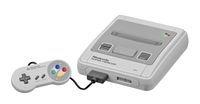Super Nintendo Entertainment System: Difference between revisions
No edit summary |
No edit summary |
||
| Line 1: | Line 1: | ||
[[Image:SNES.jpg| | {{System-Infobox | ||
|Image=[[Image:SNES.jpg|300px]] | |||
|Years=1990-1996 | |||
|Bit=16 | |||
|Pre=[[NES]] | |||
|Pro=[[N64]] | |||
}} | |||
The '''Super Nintendo Entertainment System''' (abbreviated to SNES, Super NES or Super Nintendo, Japanese: '''Super Famicom''') is a video game console created by [[Nintendo]]. It was the successor to the original [[Nintendo Entertainment System]] and rivaled in performance to the Sega Mega Drive/Genesis. It had many popular games, including ''[[Super Mario World]]'', ''[[Super Mario All-Stars]]'' and ''[[Super Mario World 2: Yoshi's Island]]''. Other, less popular titles are ''[[Super Mario RPG: Legend of the Seven Stars]]'' and ''[[Mario Paint]]'' | The '''Super Nintendo Entertainment System''' (abbreviated to SNES, Super NES or Super Nintendo, Japanese: '''Super Famicom''') is a video game console created by [[Nintendo]]. It was the successor to the original [[Nintendo Entertainment System]] and rivaled in performance to the Sega Mega Drive/Genesis. It had many popular games, including ''[[Super Mario World]]'', ''[[Super Mario All-Stars]]'' and ''[[Super Mario World 2: Yoshi's Island]]''. Other, less popular titles are ''[[Super Mario RPG: Legend of the Seven Stars]]'' and ''[[Mario Paint]]'' | ||
Revision as of 23:54, September 16, 2008
Template:System-Infobox The Super Nintendo Entertainment System (abbreviated to SNES, Super NES or Super Nintendo, Japanese: Super Famicom) is a video game console created by Nintendo. It was the successor to the original Nintendo Entertainment System and rivaled in performance to the Sega Mega Drive/Genesis. It had many popular games, including Super Mario World, Super Mario All-Stars and Super Mario World 2: Yoshi's Island. Other, less popular titles are Super Mario RPG: Legend of the Seven Stars and Mario Paint
The Super Famicom was released in Japan on November 21, 1990. The Super Nintendo Entertainment System was released in Europe in April, 1991, in Australia in July, 1991 and in America in August, 1991. Production ended in 1999, but the Famicom model was made until 2003. New games were released until 2000. It remained popular throughout the 32/64 bit era. There was also an add-on planned for it called the SNES CD. Nintendo worked with Sony to create this to rival against Sega CD. Unfortunetly Nintendo's cooperations with Sony crumbled so the SNES CD was moved to Philips for a short time. The project resulted in the CD-i.
The SNES was re-released as the SNES 2, being released at the same time and had the same RF chip to the Nintendo 64. Also it was smaller and lacked the eject button.
SNES Mouse
The SNES Mouse was an accessory for certain SNES games. It was compatible only with the SNES and was thus only used in the early-to-mid-1990's. The SNES Mouse mimics the appearance and action of an actual computer mouse; the SNES Mouse controlled the Stripe Pointer in some Mario games.
The SNES Mouse was originally bundled with Mario Paint and a mouse pad for $59.95.
Mario Games Compatible With the SNES Mouse
- Mario Paint
- Mario and Wario
- Mario's Early Years! Fun with Letters
- Mario's Early Years! Fun with Numbers
- Mario's Early Years! Preschool Fun
Super Famicom
The SNES was based on a Japanese console called the Super Famicom. Famicom was a portmanteau of Family and Computer. There are obvious performance and aesthetic differences between the two consoles. It was re-released as a Super Famicom Jr., matching a USA SNES 2, but obviously, with the same differences as the SNES 1 and Super Famicom had.
See Also
- Super Game Boy, which makes it possible to play Game Boy games on the SNES.
Trivia
- The PAL SNES (pictured) is a mix between the Super Famicom and the USA SNES, keeping the design of the Super Famicom, but keeping the name from the USA version.
- The SNES is used as the setting for the microgame "Super Nostalgic Entertainment System" in WarioWare: Smooth Moves.
Game Gallery
- DKC.jpg
- SMK BoxCover2.jpg
- 250px-Super mario world box.jpg
- WWOODSbox.JPG
- Boxartfront.jpg
- Box ysafari pal.jpg













